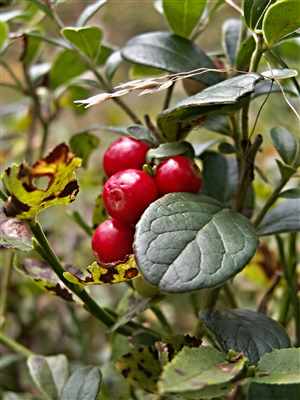Cranberry (Vaccinium macrocarpon, Oxycoccus quadripetalus)
Main Facts about Cranberry

Cranberry is a creeping evergreen shrub, 1-3 feet tall, that grows in mountain forests and damp bogs from Alaska to Tennessee. It has leathery, green leaves, pink or white flowers followed by white fruit, turning deep red when ripe. Cranberry blooms from late spring to late summer and produces fruits in fall.
Parts used – fruit.
European colonists in eastern North America called the plant Craneberry because its curved flower petals and anthers reminded them the head of a crane. Native Americans used Cranberry as food, making it into cakes or mixing it with meat to make pemmican, a prototype of a protein energy bar.
Using Cranberry
Cranberry fruits, which are high in vitamin C, were at one time eaten to prevent scurvy, a disease caused by vitamin C deficiency. The berries contain anthocyanins and flavonol glycosides, which have antibacterial properties and can help prevent degenerative diseases.
Cranberry is famous for its ability to help prevent urinary tract infection (UTI), a bladder infection that causes burning pain on urination, although there is little evidence that Cranberry can cure an infection once it’s begun. It works by preventing the bacteria E.coli from taking hold on the bladder wall and setting up an infection. This fruit is particularly useful for women who experience recurrent UTIs, as clinical trials indicate that, over a 12-month period, the frequency of UTIs in women taking Cranberry is significantly reduced. Other people who are prone to recurrent UTIs – such as the elderly and people with spinal cord injuries – may also benefit from taking Cranberry as a prophylactic, but there is not as much scientific data available to confirm its efficacy in these groups of people.
The same compounds are said to help prevent various types of bacteria from forming dental plaque, and some preliminary research suggests Cranberry could inhibit the growth of Helicobacter pylori, a bacteria that can cause stomach ulcers. Cranberry also might benefit men with chronic prostatitis.
Cranberry can be taken in juice, tablet or capsule form. Pure Cranberry juice is highly acidic and too sour to drink, which is why water and sugar are added to the commercial juice. If you decide to take the juice for medicinal purposes, you’ll need to calculate how many glasses of juice you require, depending on the percentage of Cranberry that’s present in the product. Alternatively, Cranberry tablets and capsules are made from concentrated juice.
Drink ½ to ¾ cup of juice twice per day. Take 300-500 mg concentrated Cranberry juice extract in capsules two times per day.
Cooking with Cranberry
Because of their tartness, Cranberries are generally cooked with sugar when they are made into sauces, jellies, jams, and baked goods. The fruits can also be dried and eaten like raisins or added to salads and desserts.How to grow Cranberry

| Cramp bark |
Cumin
|